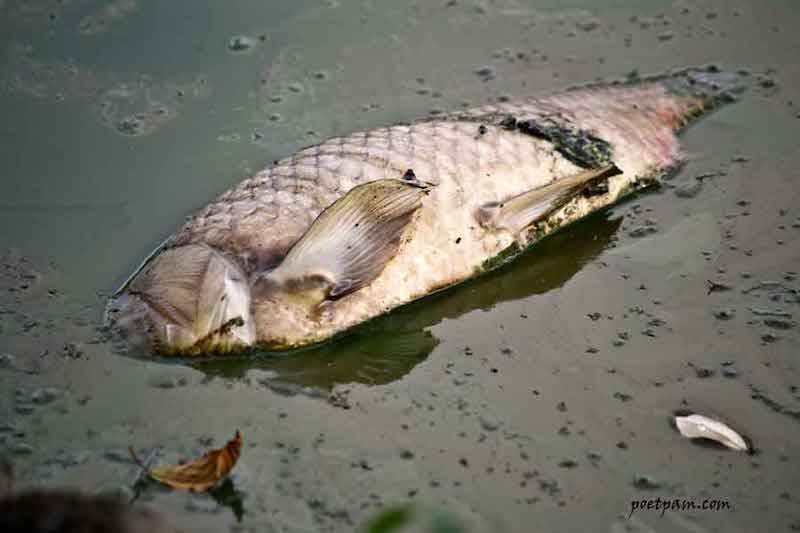Re: Here are some possible explanations for the carp die off in Stanley Park’s Lost Lagoon
While Vancouver’s Board of Parks and Recreation (VBPR) has been focused on an ill-conceived and rather cruel plan to euthanize the (verifiable?) thirty-five coyotes living in Stanley Park, Lost Lagoon has sunk into a state of decay and death.
Anyone who walks or jogs the trail around Lost Lagoon with their eyes open cannot help seeing that the once plentiful resident populations of ducks, geese and gulls are gone; they fled several weeks ago when algae bloom turned the water toxic.
And now, dead carp can be seen everywhere. Two dozen pictures of the floating corpses are attached, including those of others gasping for breath around the few drain pipes that were seeping meagre streams of “fresh” water into the polluted pond.
Normally, seasonal algae blooms come and go; but, not this year. What started as a beautiful, bright green summer bloom has lingered and intensified. It has gotten thicker, turned brown and become toxically fetid. The opacity of the once clear lagoon water can be seen in the attached photos.
Part of the problem stems from the stagnancy of the lagoon. Beavers have dammed the pond’s major inlets of fresh water. That situation has been developing for several years.
A few years ago, a three-inch diameter (!) piper was laid under the most offending dam, by the Stone Bridge. It wasn’t long until the beavers and natural sludge accumulation (fall leaves, etc.) choked off even that exiguous source. And now there is another formidable dam by the Wood Bridge.
Rain has become the lagoon’s only source of refreshment. By late summer, the water level was the lowest we’ve seen in the last twenty years. Carps’ dorsal fins broke the surface making it seem the lagoon was filled with little sharks.
Although one might think this week’s rain was a heavenly salvation – lagoon levels rose a good three or four inches – the deluge was so intense that the muddy bottom was churned, adding to the turbidity and toxicity of the pond water.
The stated objective of VBPR is to return Lost Lagoon to a more natural state - to let Nature do Her thing, so to speak. That sounds noble and makes for good PR; but the result has been, if anything, ignoble. What was once a vanguard for Vancouver’s efforts at Nature conservancy – Lost Lagoon was one reason Vancouver was selected as the world’s greenest city – will soon turn into a swamp and then a giant bog.
One small remedial step would be to get rid of the offending beaver dams and let flowing waters flush away the toxins, so the fish can breathe again.
Another (better) solution would be to repair the fountain, which has been out of commission for a few years, contributing to the lagoon’s stagnation. Besides being a sight to behold, the fountains aerate and circulate the water.
Maybe, then, water fowl will return.
Or, maybe, the Parks Board considers that fish and birds are as expendable as the coyotes, who lived in Stanley Park long before we did. (We haven’t seen the raccoons recently, either.)
Without mitigation, Lost Lagoon will, indeed, live up to its name; and that would be a shame.
Douglas Mesney

.png;w=120;h=80;mode=crop)



.png;w=120;h=80;mode=crop)